LG 34GN850 34″ Review: The New 21:9 Ultrawide Performance King
The LG 34GN850 is the company’s latest 34″ 3440 x 1440 ultrawide display and the direct successor to the LG 34GK950F from a few years ago, which was the best performing ultrawide display we had tested at the time. That monitor remained a great choice among high-end ultrawides for a long time, especially if you could find it below the $1,000 mark.
The LG 34GN850 iterates on that winning formula with a few notable improvements. LG is still using an IPS panel, but they’ve upgraded it to their latest 1ms Nano IPS tech, the same good stuff present in LG’s popular 27GL850. The 34GK950F was no slouch in terms of response times, but this new ultrawide panel should elevate the 34GN850 to the next level.
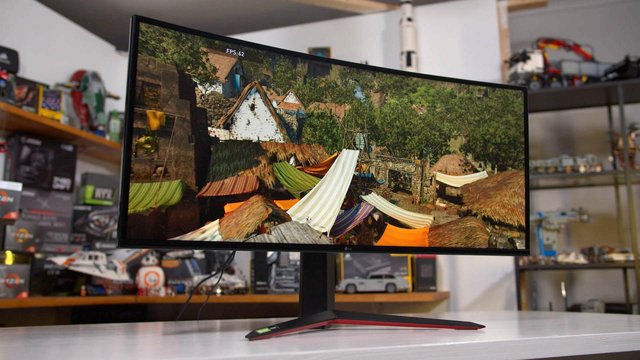
LG have also found a way to increase the refresh rate, now topping out at 160Hz, up from 144Hz, through an overclocking option in the OSD.
We’re not huge fans of companies advertising these refresh rates as “overclocking,” as it’s usually a way for them to avoid fixing units that can’t quite hit the advertised 160Hz refresh rate. That said, while you might not get 160Hz on every 34GN850, we’d expect the vast majority to work at that refresh rate and certainly our unit had no issues. In either case, LG guarantees 144Hz on this display.
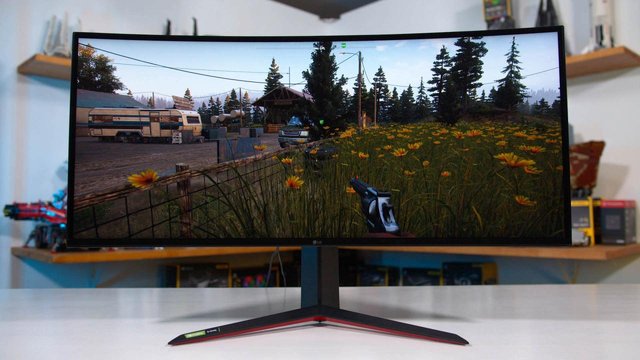
Other features include a 1900R curve, which is slightly less curved than the previous 1800R curve LG used. It’s interesting that while Samsung are pushing for bigger, more extravagant curves on their displays, LG is pulling back a bit and using 1900R or even 2300R curves on some of their latest ultrawides.
The difference between 1800R and 1900R is noticeable in a side-by-side comparison, but outside of that it’s a negligible difference and to us, either curve is suitable for an ultrawide. We actually like the curved nature of 21:9 displays.
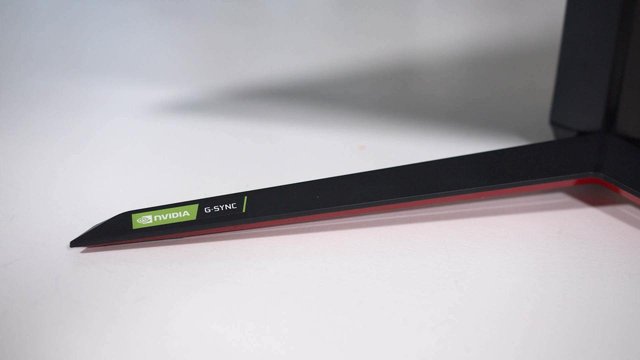
There’s also the usual adaptive sync functionality, listed as Nvidia G-Sync Compatible – meaning it will work with Nvidia cards without setting adjustments – and supporting AMD FreeSync with low frame rate compensation. There is DisplayHDR 400 certification, too, but no local dimming support, so realistically this monitor is not HDR capable.
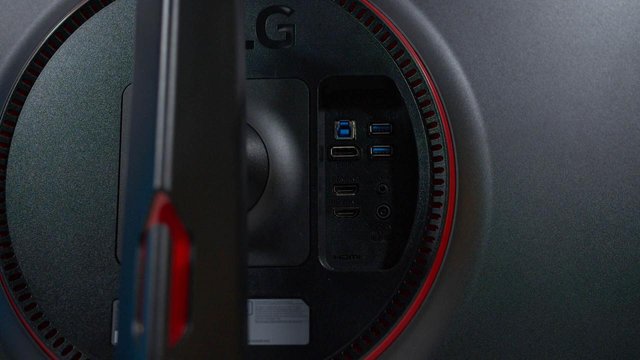
The overall design of LG monitors hasn’t changed much in the last few years. The display section retains its simple black plastic finish, moderate bezel size and circular rear design with red highlights. The ports are still directly accessible on the back of the monitor, which we like for its ease of access, you get two HDMI ports and a DisplayPort plus a USB hub and audio output jack.
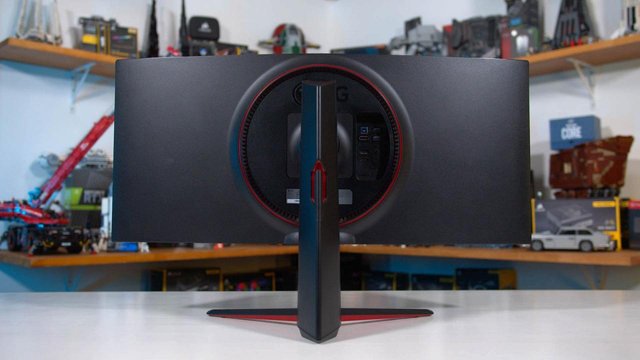
The main change LG has made with this year’s ultrawide is the stand, which is smaller and has fewer visible red highlights. The 34GK950F had a large and wide Y-shaped stand with a circular pillar, which wasn’t the easiest to operate for height adjustment.
The 34GN850 changes that to a more angular pillar which is sturdier and easier to use, although its range of height adjustment is only average. We also feel the stand design is a little strange, particularly where the legs connect to the pillar, but that’s a minor nitpick.
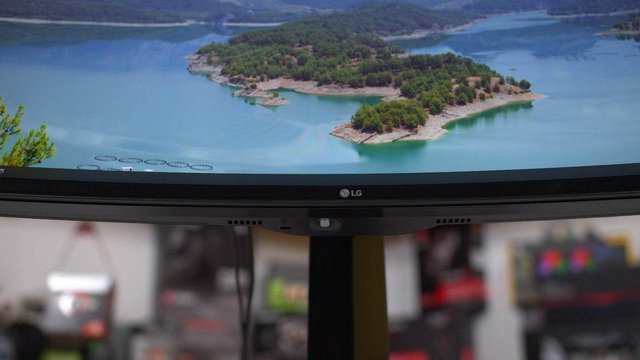
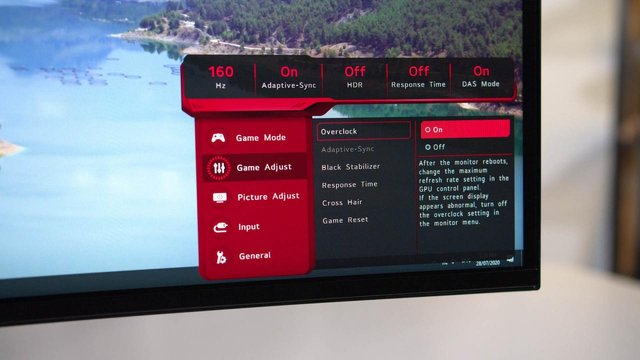
The OSD is controllable through a directional toggle right below the LG logo. There is a black stabilizer and cheat crosshairs, but that’s about it. A notable omission here is no backlight strobing mode, although as we found from the ViewSonic XG270QG, these new Nano IPS panels are essentially incompatible with backlight strobing due to the backlight’s design, which causes notable red fringes while using a strobing feature. ViewSonic included this feature and it was unusable, LG has decided not to which we feel is a better choice.
We know the 34GN850 uses 1ms class Nano IPS technology, so this should mean 27GL850-like performance right? Well, let’s take a look, starting with the first of four included overdrive modes.
Display Performance
Response Times / Overdrive Modes
LG 34GN850 – 160Hz (off)
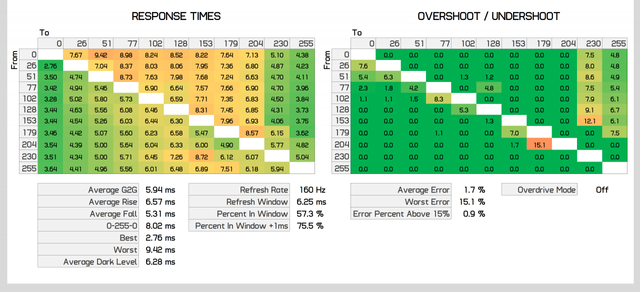
At 160Hz, using the overclocking option, the Off mode delivers a 6ms grey to grey average with minimal overshoot. This is impressive for native panel performance, we get around 75% refresh rate compliance at 160Hz in this mode which on most monitors would be borderline acceptable performance. But we don’t think many gamers will choose to use the Off mode with this monitor.
LG 34GN850 – 160Hz (normal)
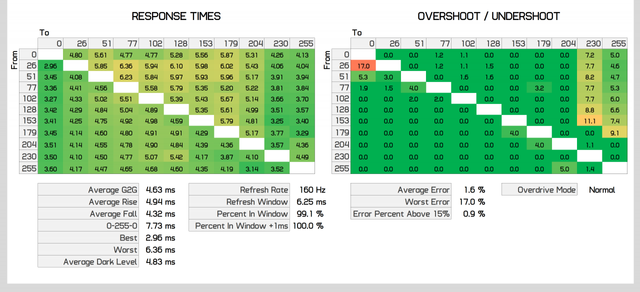
The normal mode takes us up a notch to a 4.63ms grey to grey average, also with minimal overshoot. This is quite decent and a good option for those that don’t want to tolerate overshoot across the refresh range. However, it’s not the fastest nor the optimal choice.
LG 34GN850 – 160Hz (fast)
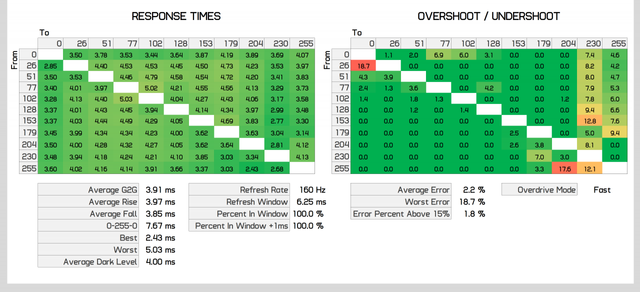
The best mode for most users, and also the default option, is the Fast overdrive mode. Here we see excellent performance, with a 3.91ms grey to grey average at 160Hz, which is fast enough that all transitions tested were within the 6.25ms refresh window – this means no smearing, and a true 160Hz experience. We also saw minimal overshoot at this refresh rate, so the experience is fast and super clean.
LG 34GN850 – 160Hz (faster)
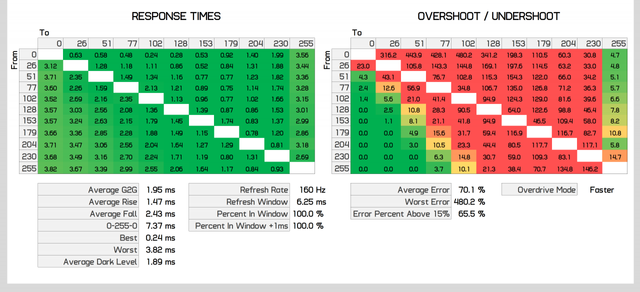
There’s also the Faster overdrive mode available, but this is mostly just so LG can advertise a “1ms” response time with this display. Yeah, in this mode some transitions are 1ms or faster, but that comes at the expense of insane overshoot and inverse ghosting. This mode is unusable due to white trailing and haloing.
LG 34GN850 – 144Hz, 120Hz, 100Hz, 85Hz, 60Hz (fast)
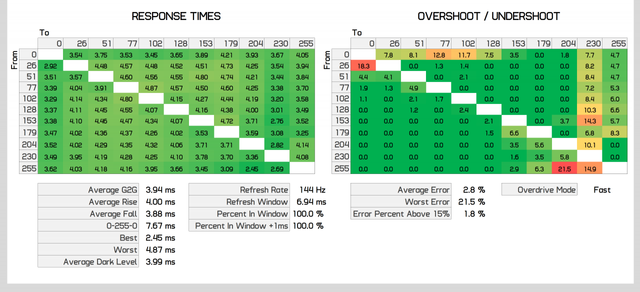
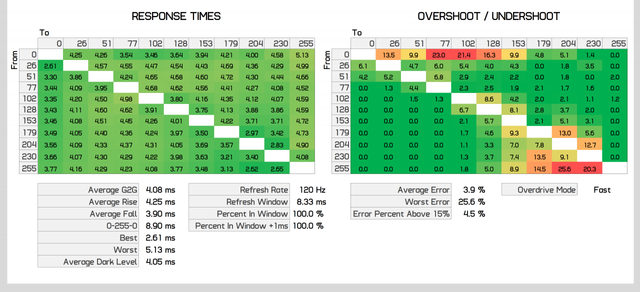
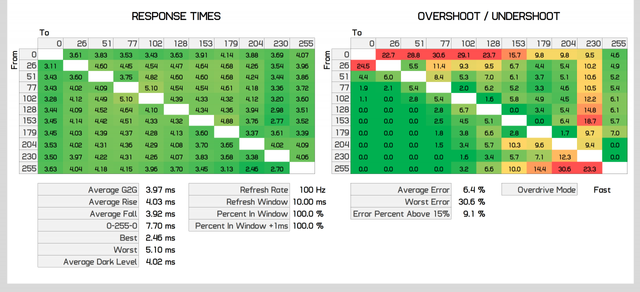
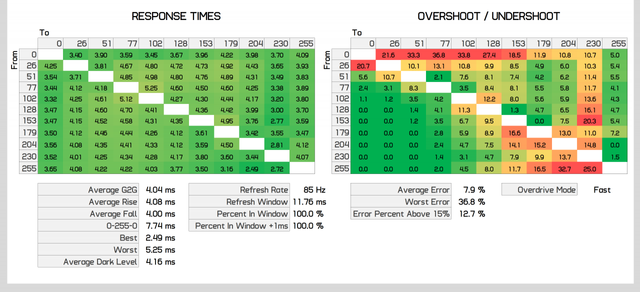
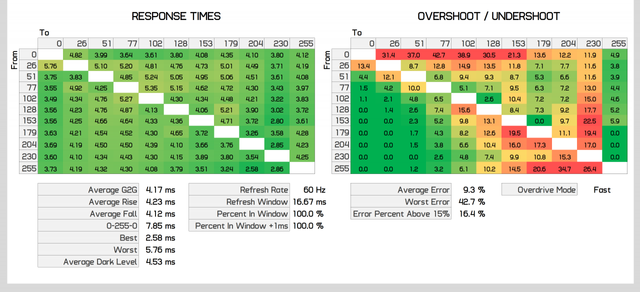
The other impressive aspect to the 34GN850 is that when you use the Fast overdrive mode, solid performance is maintained across the refresh range, and especially at the high end. The monitor consistently delivers a 4ms response time experience at all refresh rates tested, and even as we move down to 100Hz, the level of overshoot is minimal. At 85Hz, and then 60Hz, overshoot does start to creep up but even at 60Hz it’s not very noticeable so if you are gaming around that 60Hz region, the Fast overdrive mode is still perfectly fine.
This makes the 34GN850 one of few monitors that has a single optimal overdrive mode for adaptive sync gaming. We would expect this for a high-end display, but it’s always nice when you can actually just set one overdrive mode and not have to think about which refresh rates you might be using most of the time.
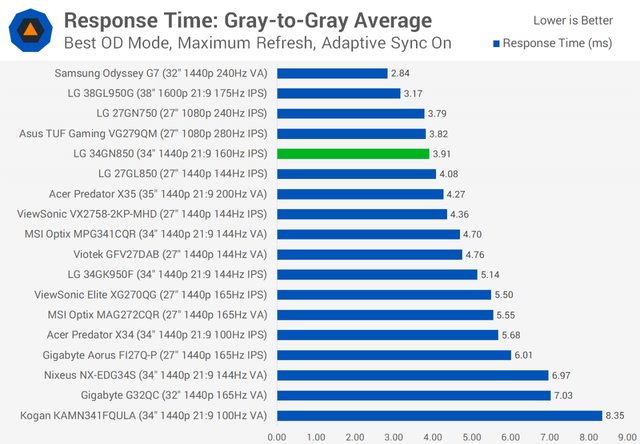
Comparing the 34GN850 to other monitors paints a very positive picture for the new LG ultrawide. As expected, we are seeing 27GL850-like performance from this monitor, almost matching its response time and inverse ghosting performance.
The 38GL950G which uses the same 1ms class Nano IPS panel technology is a little faster in terms of response times, but produces more overshoot. Generally around this 3 to 4ms mark is the limit of these IPS panels and all three monitors average a 4ms response time across the refresh range using their optimal overdrive modes.
This does put the 34GN850 in a class-leading position for 21:9 monitors. This display is 1ms faster than the 34GK950F, or about 20% faster, when comparing maximum refresh rates. But the 34GK950F does not hold this performance across the refresh range (it’s more like a 7-8ms monitor with mid range refreshes), so at times the 34GN850 can be nearly twice as fast.
The 34GN850 is also clearly faster than VA offerings, including speedy 200Hz G-Sync Ultimate displays like the Acer Predator X35. Options like the Nixeus NX-EDG34S which have in recent times pushed up to 144Hz with VA panels, are still mid-range contenders and don’t really get close to what the 34GN850 is offering.
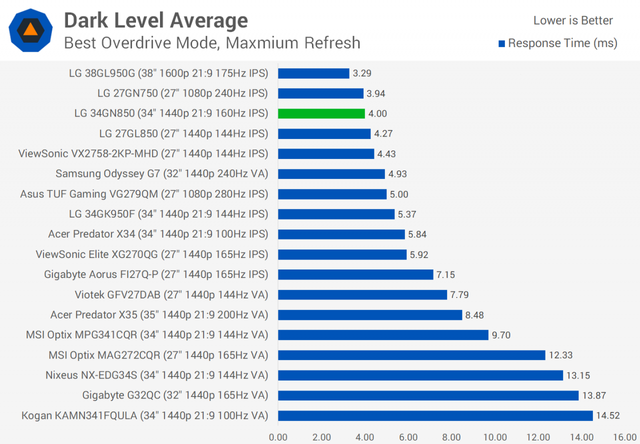
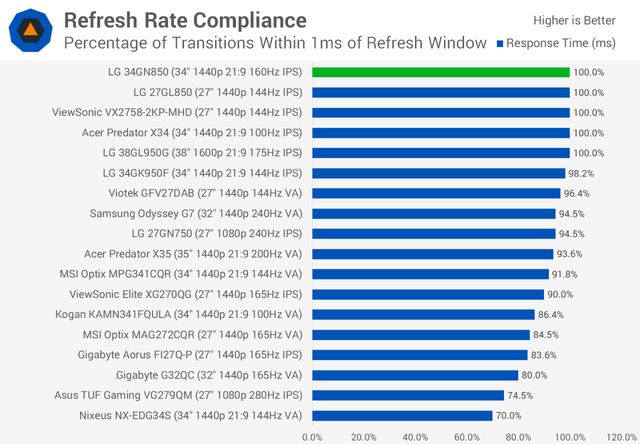
Dark level performance, as we’ve seen many times, is a non issue with IPS displays. Same with refresh rate compliance, this latest batch of IPS technology is clearly fast enough to handle refresh rates like 160Hz.
Error rates are decent, indicating LG aren’t pushing this panel too hard to achieve the level of performance we’ve been showing. Given that the Fast overdrive mode is suitable for use with all refresh rates, this is a great result for this ultrawide.
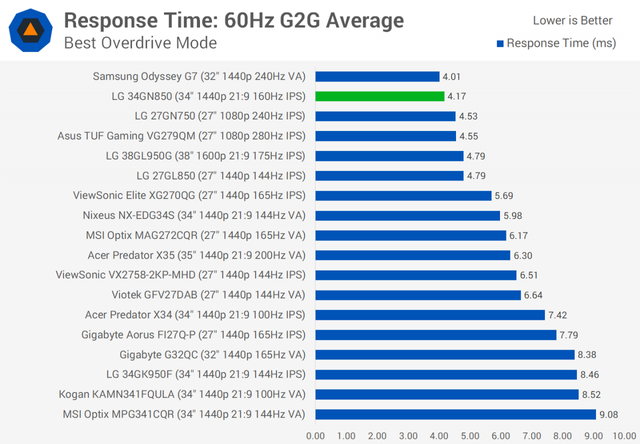
Then at 60Hz, you’ll see what we were talking about earlier. While the 34GK950F has fallen away to an 8ms grey to grey response at this refresh rate, as overshoot is too high with better performance, the 34GN850 remains rock solid with its 4.17ms grey to grey average.
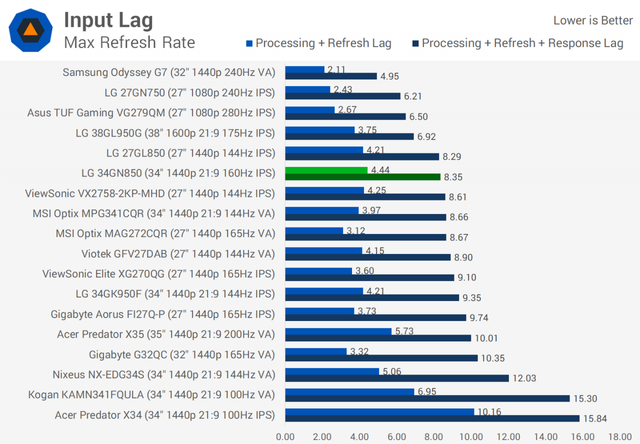
Input lag is acceptable, at a touch over 1ms, which leads to a responsive experience. As the panel also refreshes at 160Hz, it’s marginally faster and less blurry than current 144Hz options, although the difference is pretty small. We’re only talking 11% faster, which is nice to have, but reasonably negligible in the grand scheme of things.
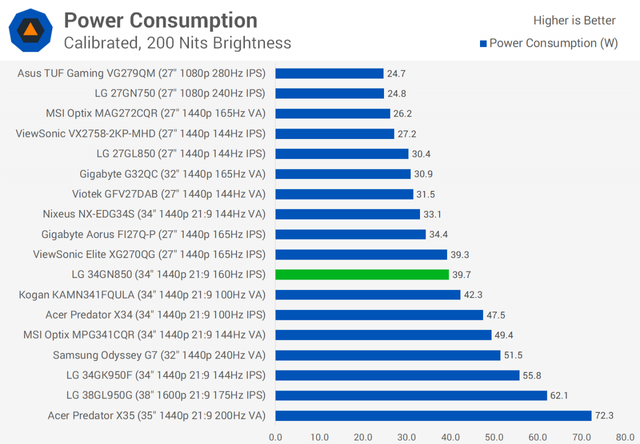
Power consumption is surprising: the 34GN850 is a lot more efficient than the 34GK950F. The 950F was a bit of an outlier for power consumption at this size, resolution and refresh rate; the 34GN850 pulls itself back into the pack with nearly 30% lower power usage at the same level of brightness. For many people this is probably not significant, but it does reduce the monitor’s heat output which we’ve heard people complain about at times for various monitors.
Color Performance
Color Space: LG 34GN850 – D65-P3
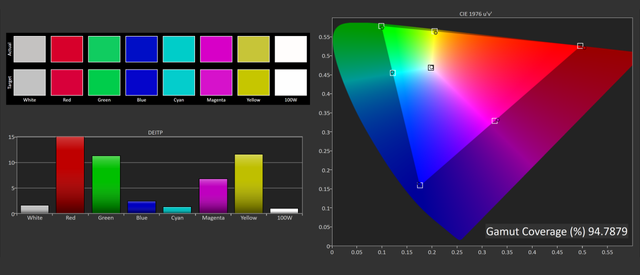
The 34GN850 is a wide gamut monitor with 95% P3 coverage in our testing, which is in the top bracket of wide gamut panels; you’ll be hard pressed to find a gaming capable monitor with better P3 coverage right now. This makes LG’s series of Nano IPS panels quite suitable as dual-use monitors for creative work as well as gaming.
Default Color Performance
LG 34GN850 – D65-P3, tested at native resolution, highest refresh rate
Portrait CALMAN Ultimate, DeltaE Value Target: Below 2.0, CCT Target: 6500K
Grayscale, Saturation and ColorChecker
Out of the box greyscale performance is decent, and indicates some level of factory calibration. Our unit had a very slight warm tone, but good adherence to the sRGB gamma curve by default. These results are above average, particularly deltaE performance, which is fantastic for this sort of panel without any calibration.
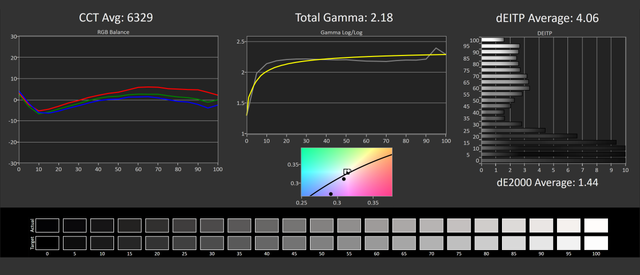
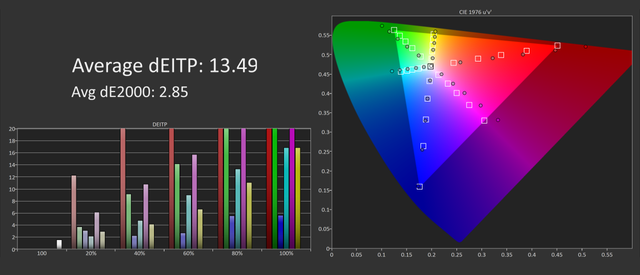
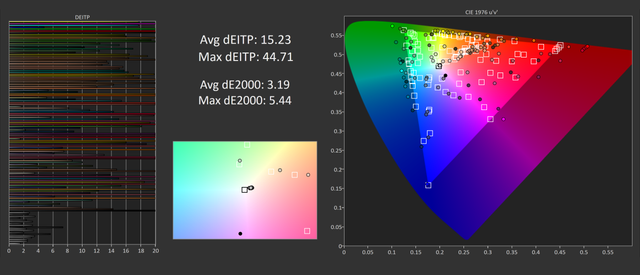
Saturation when assessing this display against sRGB suffers from the usual lack of an sRGB gamut clamp, which noticeably oversaturates colors. This is especially significant on such a wide gamut panel, although due to strong greyscale performance the damage is limited. The deltaE performance you see here in our saturation and ColorChecker tests is decent for a non-clamped wide gamut monitor but naturally it isn’t accurate.
sRGB Mode
LG 34GN850 – D65-P3, tested at native resolution, highest refresh rate
Portrait CALMAN Ultimate, DeltaE Value Target: Below 2.0, CCT Target: 6500K
Grayscale, Saturation and ColorChecker
The good news is the 34GN850 does come with a functional sRGB mode that clamps the monitor to the sRGB gamut. This significantly improves saturation and ColorChecker results, with low deltaEs in line with what we’d expect for this mode. The bad news, is that the sRGB mode locks you out of all color controls except brightness and contrast, so you are stuck with whatever greyscale calibration you get from the factory. In our case, this means the slight warm tone is unfixable in this mode. You also can’t change the overdrive setting, which is strange, but luckily defaults to the optimal Fast mode.
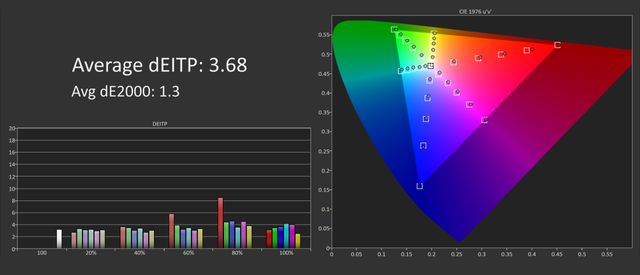
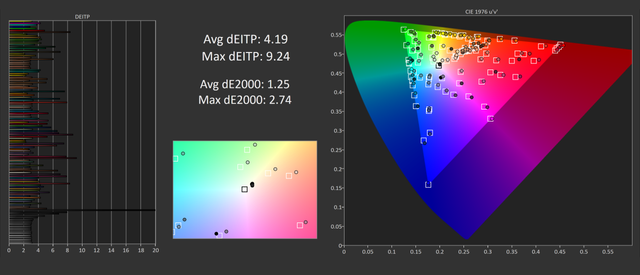
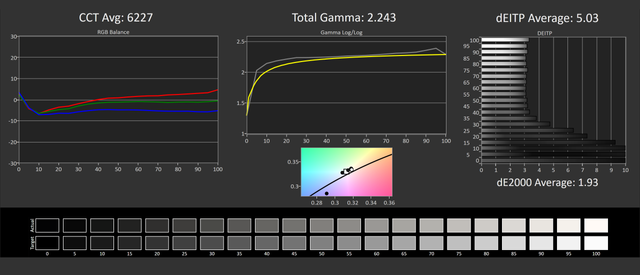
OSD Tweaked Color Performance
LG 34GN850 – sRGB, tested at native resolution, highest refresh rate
Portrait CALMAN Ultimate, DeltaE Value Target: Below 2.0, CCT Target: 6500K
Grayscale
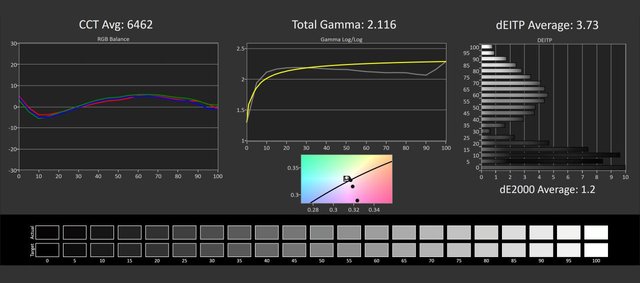
For OSD tweaking this now leaves you with a choice: do you use the sRGB mode to fix oversaturation, at the expense of greyscale tweaks? Or do you forgo sRGB clamping to fix greyscale? Neither is fantastic, it would be great if that sRGB mode had color options unlocked. In the end we were only able to achieve minor greyscale improvements using these settings.
Calibrated Color Performance
LG 34GN850 – D65-P3, tested at native resolution, highest refresh rate
Portrait CALMAN Ultimate, DeltaE Value Target: Below 2.0, CCT Target: 6500K
Grayscale, Saturation and ColorChecker
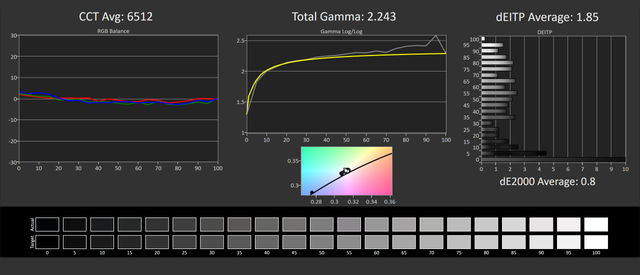
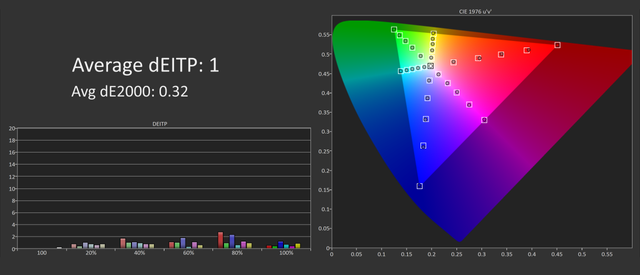
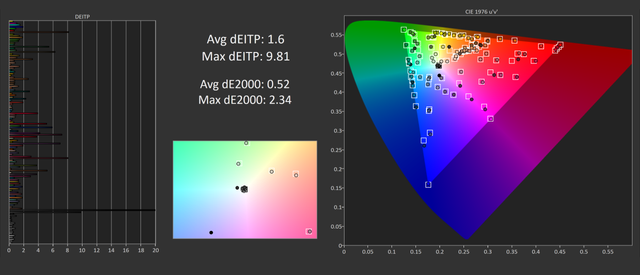
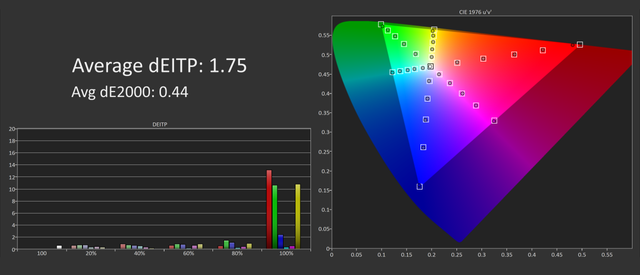
Luckily, the 34GN850 is highly calibratable in either the default or sRGB modes, because performance out of the box is pretty good.
Our results after a DisplayCAL pass delivered sub 2.0 deltaE averages across the board for sRGB content, which is excellent. And then using the same profile for P3, again very strong deltaE results, the very top end is slightly inaccurate as we don’t get full P3 coverage, but this is good enough for most creative work and well above average.
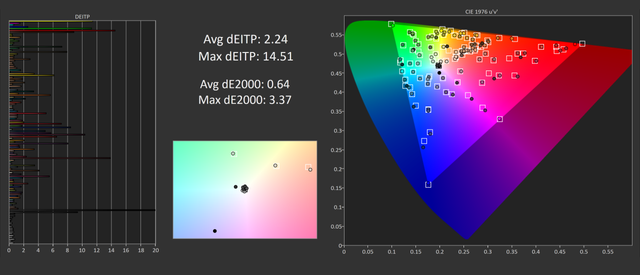
With that said, the ICC profile can only do so much, and only functions in supported applications. Watching YouTube videos in Chrome for example, does not apply the ICC corrections, so advanced users are better off switching the display to the sRGB mode and creating a profile for that mode. Then if you want to use the wide gamut of this display, switch over to the appropriate mode.
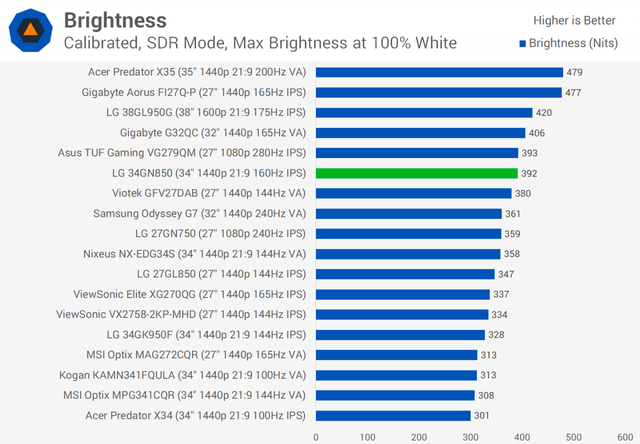
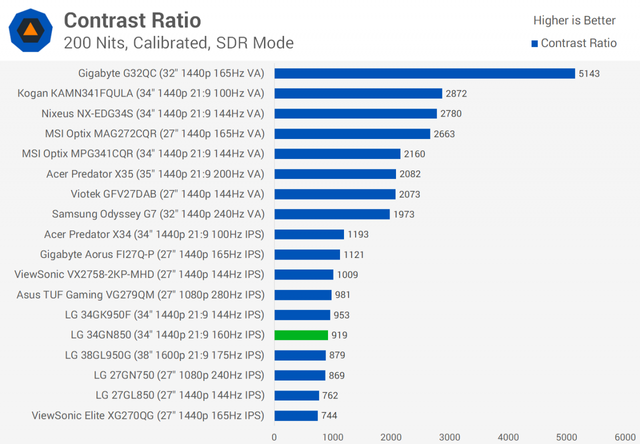
The LG 34GN850 has great brightness, nearly 400 nits which is in keeping with its DisplayHDR 400 rating, although it does lack true HDR functionality. Meanwhile, the contrast ratio will disappoint buyers, which is the biggest issue with LG’s Nano IPS panels.
The good news: calibrated contrast ratio with our unit was only marginally lower than the 34GK950F, which used older IPS technology. At a 920:1 ratio, it was also higher than our 27GL850 unit, actually 20% higher which is substantial.
The bad is that the contrast ratio is lower than other IPS panels, such as the older Acer Predator X34 which is about 30 percent better for black levels and therefore contrast. VA ultrawides naturally have an advantage as well, anywhere from 2x to 3x the contrast ratio. This isn’t a bad showing from LG’s Nano IPS panel all things considered, and isn’t that big of a deal in moderate to bright lighting conditions, but it is a weak spot for this monitor.
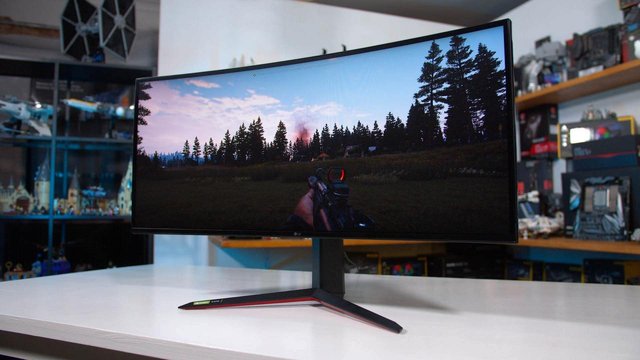
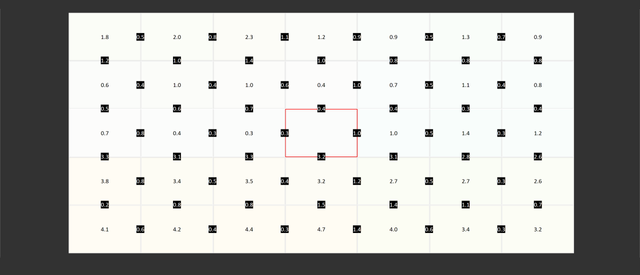
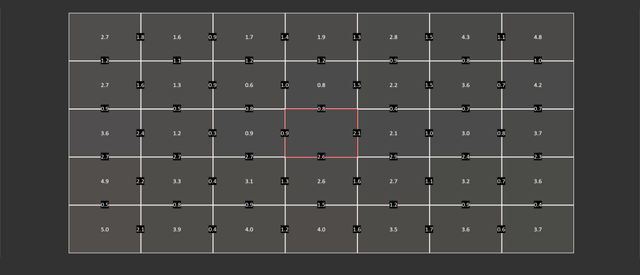
Viewing angles are excellent as you’d expect from an IPS panel. Uniformity is a little below average with our unit, the bottom half was slightly warmer than the top half, which is a regression compared to the 34GK950F and this had a similar influence on grey uniformity. However, my 34GN850 had a lot less IPS glow in the bottom left and right corners than my 34GK950F, this monitor (at least our unit) was much better than average for IPS glow and while it’s not perfect – very few IPS monitors are – I don’t think you’ll notice this issue in most conditions.
What We Learned
Overall, the LG 34GN850 is an excellent high-end ultrawide monitor and makes meaningful improvements to the 34GK950F, the previous best 3440 x 1440 choice. In moving to LG’s 1ms-class Nano IPS panel technology, response time performance is anywhere from 20% to 100% better depending on the refresh rate, and the monitor is now able to offer consistent performance with a single overdrive mode throughout the refresh range. You get a much clearer image than other 21:9 monitors on the market as a result, and the bump up to a 160Hz refresh rate is a nice bonus.
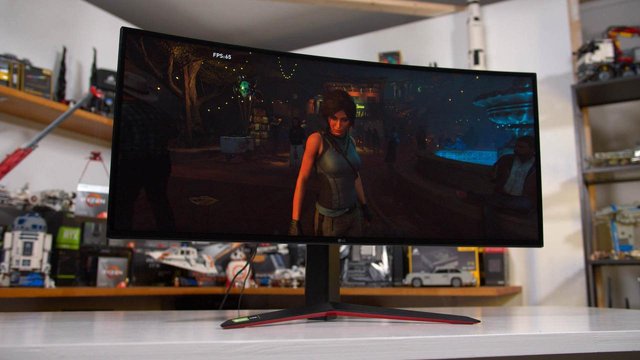
You can really think of this monitor as an ultrawide version of LG’s excellent 27GL850. Response times are very similar, you get outstanding viewing angles, top notch wide gamut colors and factory calibration isn’t too shabby either. Even IPS glow is improved, especially compared to the 34GK950F. If you’re after an ultrawide that delivers an elite combination of speed and visual quality, with the possibility to double as a creative or productivity monitor, there is no better choice than the 34GN850.
That’s not to say the 34GN850 is the perfect monitor. Contrast is the main weakness here, although it’s not worse than the 34GK950F, and isn’t as low as the 27GL850 despite using the same panel type. VAs remain a better choice for black levels. There’s also a few nitpicks like the lack of backlight strobing (even if this feature could never work with this panel), a limited sRGB mode and average design.
The even greater news is that despite all these improvements to performance, LG is introducing the 34GN850 at a lower price than is predecessor. The 950F was a $1,200 display which was on the expensive side despite its quality. Eventually you’d find it around the $1,000 mark or lower on sale, which made more sense.
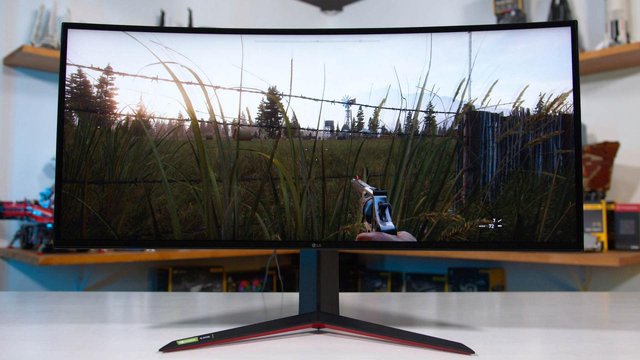
The LG 34GN850 has an MSRP of $900 which is excellent for what you get. Right now it would seem to be fetching a higher price, possibly related to the pandemic like a lot of other monitors are facing right now, but we expect that price to fall to $900 over time. A 25% reduction in launch price for a better product is a welcome improvement.
If you’re looking for something less expensive, you do have alternatives, and the LG 34GN850 remains a premium option.
Mid-range 3440 x 1440 144Hz VA monitors are ~$500 to $600 these days. You are getting a much better product for the higher price of the LG, with faster response times and better colors (outside of the contrast ratio), but this is definitely a monitor that is reserved for those that want the best of the best and are willing to pay for it.